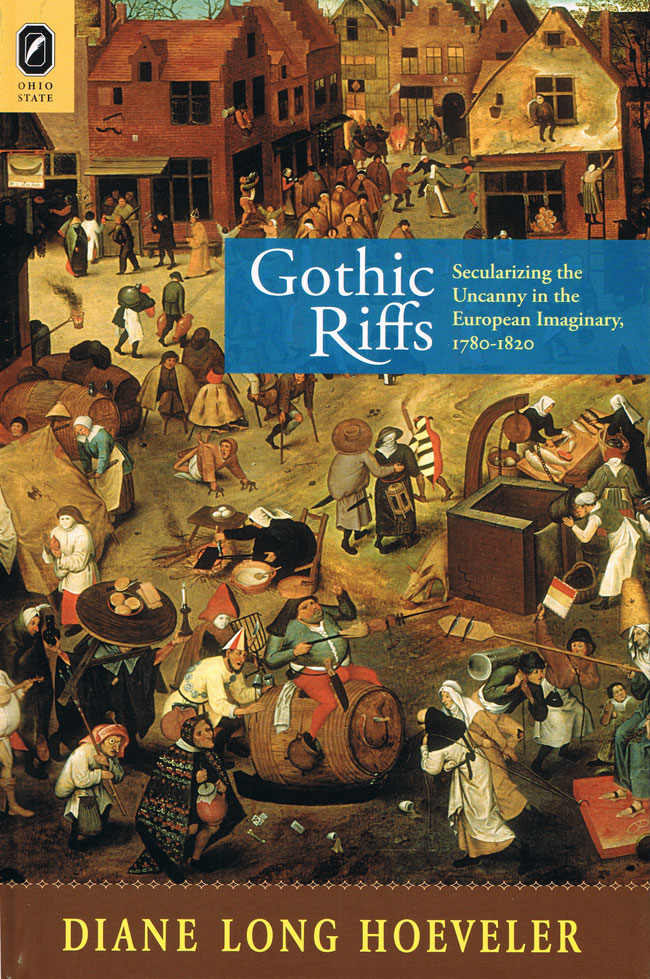Winner of the International Gothic Association’s Allan Lloyd Smith Memorial
PrizeGothic RiffsSecularizing the Uncanny in the European Imaginary, 1780–1820Diane Long Hoeveler |
 7/16/2010 Literary Criticism/Gothic & Romance 289 pp. 6x9  $57.95 cloth 978-0-8142-1131-1 Add cloth to shopping cart $14.95 CD 978-0-8142-9230-3 Add CD to shopping cart $24.95 paper 978-0-8142-5237-6 Add paper to shopping cart Shopping Cart Instructions Review/Change Shopping Cart & Check-out | |||
|
Table of Contents
Explore More International Gothic Association |
“[A]n astonishing book—in its breadth of inquiry, range of reference, and sharpness of analysis. . . . Her argument—that the gothic, in its various guises, mediates the contradictory social and religious currents of its era—is both provocative and convincing.” —Choice “Hoeveler’s study provides a valuable new approach to gothic literature and significantly broadens the horizons to include a spectrum of literary manifestations throughout Europe. Her study gives persistent attention to the performative aspect of the gothic . . . , beginning with the gothic opera with its elite audiences and concluding with the lower-classes fascinated by the gothic chapbooks.” —Wordsworth Circle “This is an excellent book . . . . [Diane Long Hoeveler] covers a remarkable amount of territory. In particular, she looks at Gothic as it occurs in the forms of opera, drama, melodrama, ballad, and chapbook, and in doing so addresses key areas of both popular and elite culture which have often been passed over in favor of the more enduring shape of the Gothic novel. What she shows is that Gothic was a deep-seated and deep-rooted ‘background’ which we need to see in all its complexity and range before we can approach those isolated works through which its dominance has been transmitted to the present age. The depth of reading and familiarity demonstrated is astonishing; to this I must add that this is a book which is singularly well-written, and engaging from beginning to end.” —European Romantic Review “In Gothic Riffs, Diane Long Hoeveler inverts the traditional interpretation of the rise of the Gothic. Hers is a new, and significant, argument. She shows, with great effectiveness and originality, the ubiquity of Gothic in popular and high art forms alike, from opera, to ballads, to chapbooks, as trans-European phenomena. I know of no modern work that aims to bring all of these different fields together in one impressively extensive book.” —Robert Miles, professor and chair, department of English, at the University of Victoria “Diane Long Hoeveler’s Gothic Riffs is genuinely innovative, informative, and insightful within the fields of both Gothic and Romantic literary studies. Indeed, this book should come to occupy a special niche of its own in the proliferating explosion of scholarship on the many kinds of Gothic that has continued to grow since the 1980s.” —Jerrold E. Hogle, University Distinguished Professor, The University of Arizona Gothic Riffs: Secularizing the Uncanny in the European Imaginary, 1780–1820 by Diane Long Hoeveler provides the first comprehensive study of what are called “collateral gothic” genres—operas, ballads, chapbooks, dramas, and melodramas—that emerged out of the gothic novel tradition founded by Horace Walpole, Matthew Lewis, and Ann Radcliffe. The role of religion and its more popular manifestations, superstition and magic, in the daily lives of Western Europeans were effectively undercut by the forces of secularization that were gaining momentum on every front, particularly by 1800. It is clear, however, that the lower class and the emerging bourgeoisie were loath to discard their traditional beliefs. We can see their search for a sense of transcendent order and spiritual meaning in the continuing popularity of gothic performances that demonstrate that there was more than a residue of a religious calendar still operating in the public performative realm. Because this bourgeois culture could not turn away from God, it chose to be haunted, in its literature and drama, by God’s uncanny avatars: priests, corrupt monks, incestuous fathers, and uncles. The gothic aesthetic emerged during this period as an ideologically contradictory and complex discourse system; a secularizing of the uncanny; a way of alternately valorizing and at the same time slandering the realms of the supernatural, the sacred, the maternal, and the primitive.
| |||


 Diane Long Hoeveler
Diane Long Hoeveler